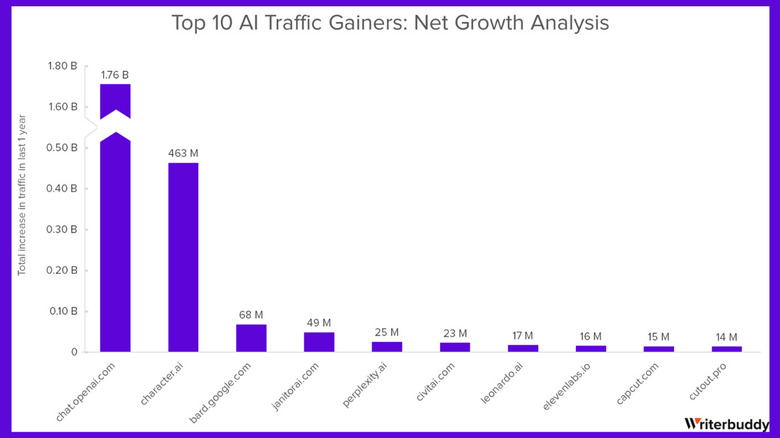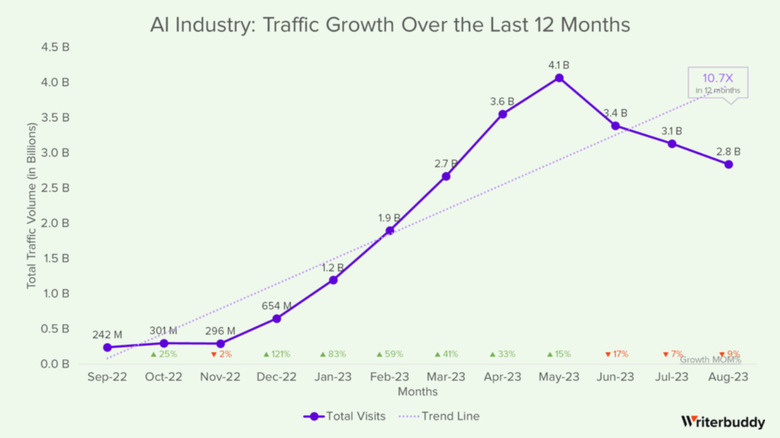The Year Of AI: Here Are The Most Used AI Tools Of 2023
Artificial intelligence was all the rage in 2023. Even the most non-techie caught wind of the rise of AI tools, if not because of ChatGPT's overnight popularity and all the internet buzz it generated, then at least from OpenAI's boardroom drama in November. Apart from mere publicity, the rapid user adoption rate is another marker of AI's popularity. From writing assistants to generative media tools, hundreds of millions — scratch that, billions — of users have incorporated artificial intelligence into their workflows in unprecedented ways.
A study by WriterbuddyAI reveals the ballpark figures: the top 50 AI tools generated 24.3 billion visits between September 2022 and August 2023, with traffic increasing by an average of 236.3 million visits per month. You probably won't be surprised to learn which AI tool(s) generated the majority of that traffic, but the data still offers some intriguing insights into the kinds of questions we all need to begin asking about an AI-enabled future.
The three most used AI tools of 2023
AI chatbots enjoyed the highest adoption rate this year, followed by AI writers. The top-rated tool on the list is both. With 14.6 billion visits or more than 60% of the total traffic studied, ChatGPT is the most popular AI tool of the year. Site traffic grew by an average of 195.1 million visits per month and 1.6 billion in the entire year period, which is significant growth for a tool that's only been public for over a year. With that kind of traffic, if AI is only a fad, it must be a very slow fad. The AI chatbot was also Wikipedia's most-viewed English page this year, receiving between 100,000 and 400,000 views per day on average and over 49 million views in total. Plus, Google Trends indicates that searches for "ChatGPT" surged more than 2,000% in 2023.
CharacterAI came in as the second most visited AI tool of 2023, although with 3.8 billion visits, it received far less than half of ChatGPT's total traffic. If this is the first you're hearing of it, CharacterAI is a chatbot that allows you to create personas based on historical figures, movie characters, or just pure imagination. These personas will respond uniquely to interaction based on their source texts and backstories. We listed it in this guide to lesser-known ChatGPT alternatives, but the tool saw a 463 million growth in traffic in the past year, so it looks like its days of obscurity are ending.
Google's AI, Bard, placed third on the list with 241.6 million visits, which is huge considering the tool was only launched in March 2023 and wasn't stable until November.
Other names on the most used AI list
Behind the top three in the previous section are:
- Janitor AI, an NSFW conversational chatbot that has seen rapid growth since its first appearance around May 2023. With about 48.1 million monthly visits and 192.4 million total traffic (in the four months considered), its adoption rate is mindblowing.
- Perplexity AI, an educational chatbot that garnered 25.3 million visits in just under nine months.
- CivitAI, an AI image generator launched in late 2022, racks up an average of 17.7 million visitors per month and a total of 23.3 million during the survey period.
- LeonardoAI, also an image-generator AI, received a total of 101.6 million visits from the time of its launch in December 2022 till August 2023.
- ElevenLabs, a generative voice tool that proves a useful AI assistant for content creators. It amassed 15.9 million visits over the 12-month study period.
- CapCut, a popular video editing app with a built-in AI tool, received 14.6 million visits in the year, with an average of 1.3 million views per month.
- CutoutPro, an AI-enabled image-enhancing tool used for automating simple editing tasks, gained 14 million in all-year traffic, with over a million in traffic growth per month.
Overall, total traffic to the top 50 AI tools saw a 10.7x growth rate in just a year, which is massive for such a nascent industry. Conversely, traffic to the AI tools Craiyon, Midjourney, Quillbot, Jasper, and Zyro decreased from the previous year. The study suggested this could be because of the more prominent competition these tools faced.
What the AI adoption surge means for the future
The data makes one thing clear: AI is more than just a fleeting trend. It might be a statement worthy of an eye roll, but it's true. The numbers make it clear that real people continue to find these tools useful, so there is little doubt that we're moving toward a future where AI is interwoven with our everyday lives. So far, something else is also clear. AI opens up a world of endless possibilities and one of fresh concerns — the AI world is uncharted territory, unlike anything we've ever dealt with before. It creates opportunities for quicker creative output but opens up just as many for academic and professional dishonesty.
Then, there's the prevalent and totally valid worry of losing jobs to AI, especially as the tools gather more experience and become more efficient. Our previous conclusion was that AI is unlikely to be used for anything other than tedious, repetitive labor, but a lot of people in our world are employed for just that kind of work. Key conversations are ongoing about the regulation, ethics, and privacy issues surrounding AI, but we are indeed unable to fully foresee how this phenomenon will alter our lives. We can and will be surprised by AI; hopefully, it will be for the better.



